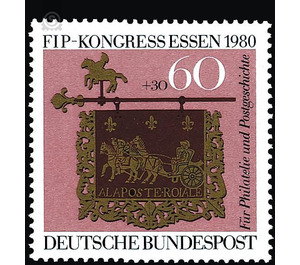FIP Congress, Essen 1980 - Germany / Federal Republic of Germany 1980 - 60 Pfennig
Theme: Art & Culture
| Country | Germany / Federal Republic of Germany |
| Issue Date | 1980 |
| Face Value | 60.00 |
| Color | violet |
| Perforation | K 14 |
| Printing Type | 4-color offset printing |
| Stamp Type | Postage stamp |
| Item Type | Stamp |
| Chronological Issue Number | 952 |
| Chronological Chapter | GER-BRD |
| SID | 460695 |
| In 39 Wishlists | |
49th Congress of the Fédération Internationale de Philétélie (FIP) in Essen Under the auspices of the Federal Minister of Posts and Telecommunications, the 49th Congress of the Fédération Internationale de Philételie (FIP) will take place on 12-13 November 1980 in the Essen Exhibition Center. the FlP Congress Essen 1980 - instead. The delegates of 57 nations from five continents affiliated to the FIP and their philatelic associations are expected to attend this congress in Essen. They make important decisions this year and elect their presidency. The FIP has existed since 1926. It carries out important tasks in the organization of international stamp exhibitions, most of which have a World Fair character, in the field of coordination of counterfeiting and the constant discussion and observation of philatelic developments. The work is carried out by the FlP President and an Executive Committee, in each of which a representative from the Federal Republic of Germany, Italy, Japan, Czechoslovakia and the United States participate. In the FlP commissions collectors protection / testing and youth, literature and motive collecting German philatelists are active in leading positions. The Bund Deutscher Philatelisten e.V. (BDPh), which is responsible for the organization and direction of the congress, represents the collectors of the Federal Republic of Germany in the FIP. It has approximately 70,000 members in 10 regional associations, 800 associations and around 150 research and development communities. For more than 30 years, the BDPh has been working with thousands of volunteers in research and literature, collectors protection, anti-counterfeiting, testing, exhibitions and youth work. Representatives of the BDPh work and decide in the Foundation for the Promotion of Philately and Postal History e.V., which has a significant share in the development of German philately. (Text: Bund Deutscher Philatelisten e.V., Frankfurt am Main) The post office sign of Altheim, Saar, from the year 1754 is because of its bilingual inscription an important and rare testimony of postal history in the German-French border area. Altheim belonged originally to the county Zweibrücken, then came by pledge to the rule Bitsch and went with her to Lorraine. There ruled since 1735 as Duke of Lorraine, the refugee Pole King Stanislaus Leszczynski, the father-in-law of King Louis XV. It had been agreed that after his death Lorraine would fall to France. The post office sign proves that even before Leszczynski's death (1766) in Altheim a French post office must have existed. Several times appear on the shield, the Bourbon lilies. In addition, the writing is German on one side: "Alhir is the Royal Bost" and on the other side is French: "A la Poste Roiale". The artistically most valuable part of the post office sign is the sawed-off vine work. At the top of both sides is a blistering postillion in a contemporary uniform. Both postilions are connected around the shield by ornaments and figures, which are partly based on the shape of the post horn and run out in both corners and down in the middle in French lilies. On the special postal stamp "FIP Congress Essen 1980" the French inscribed side of the post office sign of Altheim can be seen. (The special stamp "Stamp Day 1979" published last year showed the German inscribed side of the post office sign.) The original sign is in the Federal Post Office in Frankfurt am Main. (Text: Federal Postal Museum Frankfurt am Main)


